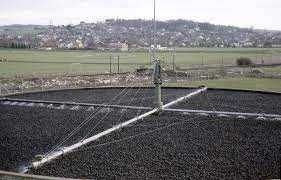The trickling filter system is relatively simple and inexpensive. It is an aerobic sewage treatment method in which the sewage is distributed by a revolving sprinkler suspended over a bed of porous material as seen in the figure below.

Fig.: Trickling Filter
The sewage slowly moves through the porous bed and the effluent is collected at the bottom. This porous material becomes coated with a dense slimy bacterial growth which provides a home for a heterogeneous microbial community which includes bacteria, fungi, and protozoa as well as other organisms.
As the sewage drains through the porous bed, this microbial community absorbs and breaks down dissolved organic nutrients in the sewage; this reduces the BOD. Aeration of the sewage occurs by the movement of air through the porous bed.
The sewage may need to be re-circulated several times through the filter in order to reduce the BOD sufficiently. One disadvantage to this system is that an excess amount of nutrients produces an excessive amount of slime on the bed which in turn reduces aeration, leading to the need to renew the porous bed.
Read Also: Meaning and Factors affecting Sedimentation in Waste-water Treatment
Cold winter temperatures also reduce the effectiveness of this method in outdoor treatment facilities.
Waste-waters from a variety of industrial processes have been treated in trickling filters. Such industrial waste-water trickling filters consist of two types:
Large tanks or concrete enclosures filled with plastic packing or other media.
Vertical towers filled with plastic packing or other media. The availability of inexpensive plastic tower packing has led to their use as trickling filter beds in tall towers, some as high as 20 meters (Millon,1967).
As early as the 1960s, such towers were in use at: the Great Northern Oil’s Pine Bend Refinery in Minnesota; the Cities Service Oil Company Trafalgar Refinery in Oakville, Ontario and at a Kraft paper mill (Bryan and Moeller, 1960).
Read Also: Industrial Wastewater Treatment Procedure
The treated water effluent from industrial waste-water trickling filters is very often subsequently processed in a clarifier-settler to remove the sludge that sloughs off the microbial slime layer attached to the trickling filter media (see Image or fig 9.3 above).
Currently, some of the latest trickle filter technology involves aerated biofilters which are essentially trickle filters consisting of plastic media in vessels using blowers to inject air at the bottom of the vessels, with either down flow or up flow of the waste-water (Sperling, 2007).

